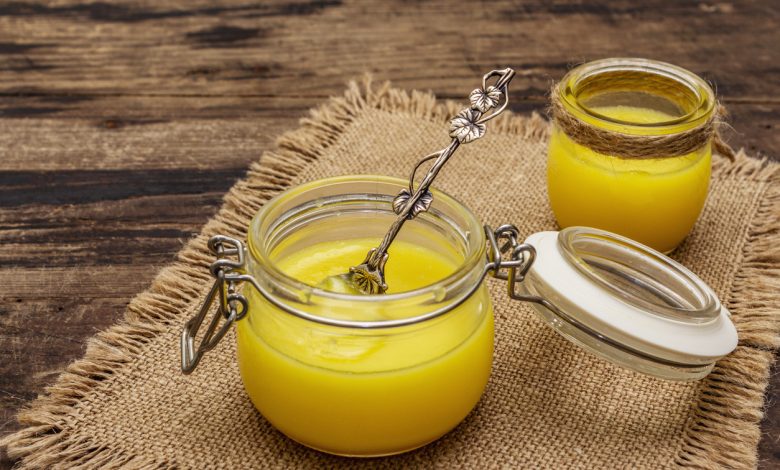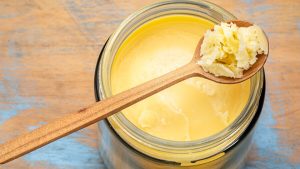Desi Ghee: The Golden Elixir of Indian Cooking and Wellness
Desi Ghee

In the vibrant tapestry of Indian cuisine, few ingredients hold as much reverence and importance as Desi Ghee. Often referred to as the golden elixir, it is not just a cooking medium; it is deeply ingrained in the cultural and wellness fabric of India. Made by simmering butter until the water content evaporates and the milk solids separate, it boasts a rich, nutty flavor and a multitude of health benefits. Join us on a journey as we delve into the historical significance, nutritional richness, and versatile applications that make Desi Ghee a prized gem in Indian kitchens and a wellness elixir with a golden touch.
A Glimpse into the Historical Significance:
Desi Ghee has a storied history, dating back thousands of years. In ancient Indian scriptures like the Vedas and Ayurvedic texts, ghee is extolled for its ritualistic and medicinal qualities. It was used in sacred ceremonies and revered as a symbol of purity and nourishment. Over the centuries, it continued to play a pivotal role in Indian kitchens, not only for its culinary applications but also for its holistic benefits.
The Nutritional Richness of Desi Ghee:
1. Vitamins and Minerals:
Loaded with fat-soluble vitamins such as A, D, E, and K, Desi Ghee supports various bodily functions. Vitamin K, in particular, is crucial for blood clotting and bone health.
2. Antioxidants:
Desi Ghee contains antioxidants that help combat free radicals in the body.
3. Lactose-Free:
Through the clarification process, it becomes virtually lactose-free, making it suitable for individuals with lactose intolerance.
4. Supports Digestion:
Ayurveda recognizes ghee as a digestive aid. It is believed to stimulate the production of digestive enzymes and enhance the absorption of nutrients.
5. Immune Boost:
The vitamins and antioxidants in Desi Ghee contribute to a strengthened immune system, helping the body ward off infections and illnesses.
Wellness Applications:
1. Ayurvedic Massage (Abhyanga):
In Ayurveda, It is used for Abhyanga, a traditional self-massage technique. The ghee is warmed and gently massaged onto the skin, promoting relaxation, improving circulation, and nourishing the body.
2. Holistic Healing (Neti Pot):
It is employed in Ayurvedic practices such as Neti, where warm saline water mixed with ghee is used to cleanse the nasal passages. This helps alleviate sinus issues and promotes respiratory health.
3. Nourishing the Mind (Brain Tonic):
Ayurvedic practitioners often recommend consuming Desi Ghee as a brain tonic. It is believed to support cognitive function and enhance memory.
4. Wound Healing (Sutruta):
In traditional Ayurvedic wound healing practices (Sutruta), ghee-soaked bandages are applied to promote recovery and reduce inflammation.
Culinary Versatility:
1. Tempering Spices:
The practice of tempering spices in Desi Ghee is a hallmark of Indian cooking. The ghee enhances the flavors of spices, creating a fragrant and aromatic base for various dishes.
2. Sautéing and Frying:
It’s high smoke point makes it ideal for sautéing and frying. Its rich flavor adds depth to vegetables, meats, and lentils, creating dishes with a distinct taste.
3. Baking and Desserts:
It lends its rich, nutty flavor to an array of Indian sweets and desserts. From halwa to ladoos, its inclusion elevates the taste and texture of traditional treats.
4. Roti and Paratha:
The tradition of spreading ghee on freshly made rotis or parathas is a culinary delight in Indian households. This simple yet flavorful addition enhances the overall dining experience.
5. Flavoring Rice and Pulao:
A dollop of Desi Ghee added to steaming hot rice or pulao imparts a luxurious richness and elevates the dish to a higher culinary plane.
Choosing and Storing:
1. Quality Matters:
Opt for high-quality Desi Ghee from trusted sources or prepare it at home. Look for ghee made from grass-fed cow’s milk for added nutritional benefits.
2. Aroma and Color:
Quality ghee should have a rich, nutty aroma and a golden to amber color. Avoid ghee with a burnt or rancid smell, as it may indicate poor quality.
3. Store in a Cool Place:
It has a long shelf life, but it should be stored in a cool, dark place away from direct sunlight. Use a dry spoon to prevent moisture contamination.
4. Homemade Ghee:
Consider making Desi Ghee at home for a fresh and pure version. The process is simple, involving simmering unsalted butter until the water content evaporates, and the ghee becomes clear.
Caution and Considerations:
1. Moderation is Key:
While Desi Ghee offers numerous health benefits, it is calorie-dense. Moderation is essential, especially for individuals watching their caloric intake.
2. Individual Health Conditions:
Individuals with specific health conditions, such as heart disease or high cholesterol, should consult with a healthcare professional regarding their ghee consumption.
Conclusion:
Desi Ghee, the golden elixir of Indian cooking and wellness, transcends its role as a cooking medium to become a symbol of tradition, nutrition, and holistic well-being. From its historical significance in ancient rituals to its culinary versatility and health-promoting properties, It remains a cherished ingredient in Indian households. As you savor the rich flavors and reap the benefits of this golden elixir, let Desi Ghee not only be a staple in your kitchen but also a testament to the timeless wisdom embedded in the intersection of culinary arts and holistic living. Embrace the golden touch, and let its warmth and richness become an integral part of your journey to culinary and wellness excellence.


